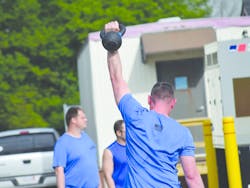Firefighters face heightened levels of physical and mental stress on a daily basis. Additionally, their career puts them at an elevated risk for cancer, cardiac issues, high stress, and job-related orthopedic injuries. These occupational hazards permeate all aspects of life and are not simply tossed aside when a work shift is over. As such, it is critical that firefighters train for maximum performance, not just improved fitness levels, so that they can thrive on and off the job.
Training for maximum performance beyond fitness includes conditioning, nutrition, sleep, stress mitigation, and resilience development. By focusing on each component of performance beyond fitness, tactical athletes can make small, incremental changes that result in sustainable lifestyle improvements so that they can finish their careers as strong as they started.
Fitness
The word “fitness” is tied most closely to physical attributes. It encompasses general physical conditioning, including cardiac health, the ability to run quickly or for long distances, and strength that is not activity-specific.
It is no secret that conditioning and general strength play a critical role in completing the tasks central to firefighting; however, training for job-specific performance beyond fitness—things like hauling ropes, climbing stairs and standing for long periods of time while wearing and carrying a significant amount of equipment—is paramount to success as a firefighter. Further, if you train solely for fitness, you may look good but not be able to perform your job at the highest level. If you train for performance of your job, the byproduct will be becoming more fit.
As such, firefighters need to follow programs based on the demands of their job. This includes task-specific conditioning based on wearing a heavy kit, operating in extreme conditions with asymmetrical movements, and using every energy system during often prolonged periods of exertion on the fireground.
While fitness is one piece of what it takes to be a firefighter, a variety of other physical and mental components complete the full picture of developing maximum performance. Along with conditioning, performance also includes injury prevention and prehabilitation. For firefighters, broadening the focus of conditioning to cover more than physical fitness level allows training plans to target and reduce the rate of sustaining the most common job-related injuries.
Along with task-specific training directly targeting the needs of firefighters, pre-workout dynamic stretching and warm-up routines develop flexibility, which diminishes risk of injury and enhances mobility (Woods, Bishop, & Jones, 2007). Things like incorporating internal and external shoulder rotations into a warm-up can help promote recovery and regeneration, and integrating yoga into a training plan can improve mobility and flexibility. Following a periodized training plan that develops conditioning in a cyclical and methodic way allows for larger strength gains (Rhea & Alderman, 2004).
Additionally, understanding pain and how it works as an internal alarm is key to preventing injury before it occurs. In his 2011 TED Talk, Professor Lorimer Moseley demonstrated that pain is not always a signal of immediate damage, but rather a warning sign that can help protect the body from sustaining impending injury. Experts like Antigone Matsakis, doctor of physical therapy, explain that feeling pain is a natural response to a potential danger or imminent risk.
When threat of injury is clear, it is easier to see how pain is an alarm system signaling that you are at risk of injury. If you place your hand on a hot stove, you will likely begin to feel the pain of an impending burn as your brain attempts to warn you to move before the heat burns you. In the case of less visible injuries, like pulling a muscle or overexertion, being able to identify pain and recognizing it as a type of injury alarm system helps firefighters see hidden factors before they result in injury.
Nutrition
Nutrition plays a key role in performance beyond fitness. In order to have the energy needed to maintain a high level of conditioning and strength, the quality, quantity, and timing of meals are crucial to maximizing performance on the job as well as long-term health and wellbeing.
When eating for fitness, you can follow general guidelines or make major dietary changes to target goals like weight loss or muscle gain that are not viable as long-term habits. On the other hand, eating for performance requires making small, incremental improvements that result in sustainable lifestyle changes. For example, small changes can include replacing a sugary drink with water or adding spices instead of extra salt to meals. These small changes can become habits that foster long-term change.
Additionally, hydration and blood sugar stabilization are key concepts to maximizing performance without letting heightened stress interfere with overall fitness and health.
Hydration is one of the smallest improvements that can have the biggest impact on performance and lifestyle. Water makes up nearly 75 percent of muscle tissue. Adding more water into your day increases energy and helps you limit your daily intake of less healthy or high-calorie options, like soda. Not only can this decrease the fatigue and energy crashes brought on by dehydration and sugary drinks, but it also can result in consuming fewer calories and lead to weight loss (Stookey, Constant, Gardner, & Popkin, 2007).
When, how much and what you eat are factors that impact blood sugar levels, which, when stabilized, allow you to feel energized, focused and attentive. Combining protein with healthy fats and complex carbohydrates will promote blood sugar stabilization. For example, foods like eggs, chicken and beans are good sources or protein; fruit has complex carbohydrates; and healthy fats can be found in salmon or nuts-like almonds. By pairing a healthy amount of these three macronutrients in each meal will help you limit cravings, maintain energy and boost metabolism. By matching your activity levels with when and how much you eat, you will create sustainable improvements that will impact your wellbeing on and off the job.
Sleep
Similar to nutrition, sleep habits play a significant role in both achieving a high fitness level and in maximizing performance. Adequate and restful sleep can improve mood, strengthen memory, and facilitate tissue repair and muscle recovery, all of which play a role in restoring energy, thinking creatively and operating at high levels of cognition functioning.
In order to mitigate the risks firefighters face due to irregular schedules and shift work, they need to be able to make any amount of sleep as restful as possible. To do this, you can develop a pre-sleep routine that triggers your brain into understanding it is time to sleep, no matter what time of day. Start by turning off your screens (i.e., phones, computers, iPads) at least an hour before you plan to sleep. Then make sure the room you sleep in is dark and cool. If you don’t have access to a dark room, invest in eye covers to block light. And, lastly try easing into sleep through guided meditations like iRest Yoga Nidra Meditation that helps to induce restful sleep (Integrative Restoration Institute, 2016).
Not only will healthy sleep hygiene improve your mood, but getting enough rest will also help you maximize your performance physically and cognitively. This will limit your risk of injury and help you manage stress levels in all situations on and off the job.
Stress mitigation
Just as a weightlifter trains muscle groups to withstand physical stress by improving strength, tactical athletes who endure psychological stress must also build mental toughness and readiness. As with physical exercise routines, there are mental conditioning tools and techniques that act as “a gym for your mind” (Trozzi, 2016).
By adding a cognitive component to training, firefighters can not only improve upon the situational awareness critical to operating under stress on the job but also upon stress mitigation and resilience development so that they can enjoy life off the job and come back mentally strong each shift. Tools like mindfulness can help you be more attentive during stressful situations and build the resilience necessary to recover from experiencing trauma.
Mindfulness, in short, is paying attention. It is the ability to see and process everything you are experiencing without judging a situation (Mindful.org, 2016). By viewing situations mindfully, you can make decisions more clearly and with heightened awareness to detail. Much like learning how pain can be a signal that you are in danger of injury, mindfulness and mental conditioning can help you recognize the signs of stress that signify impending risk.
Mental conditioning can include mindfulness drills, attention training and breathing exercises. Focusing on your breathing is a simple way to start infusing your training with mindfulness. To do this, start by counting your breaths in four counts. Breathe in for four counts, hold for four counts, breathe out for four counts and repeat that process for 5 minutes at a time. Additionally, you can practice audio awareness. Listen to nature noises or the sound of waves crashing and just listen. As your mind wanders, bring your thoughts back to the sounds rather than focusing or judging the thoughts coming into your mind. Over time you will build the skill of mindfulness just as you build strength in the weight room, and it will help you manage stressful situations and enjoy life’s non-stressful moments.
These tools will allow you to build resilience and maintain cognitive function and focus in chaotic or tense situations. Coupling mental conditioning with physical conditioning allows firefighters to do their jobs well and finish their careers stronger than they started.
In sum
The purpose of this article is not to diminish the significance of being physically strong and reaching peak fitness. In fact, it shows that physical training for firefighters is critical and must focus on job-specific tasks and functional training based on the unique demands faced on the fireground.
Firefighting is physically demanding in ways that most jobs are not; however, firefighters and other tactical athletes also face intense mental stress that can impact them after their shift or career ends. As such, firefighters and other tactical athletes must focus on performance beyond fitness, and they need tailored programs that target mental wellbeing, nutrition, and injury prevention. Because when we encounter stress or adversity, “We don’t rise to the level of our expectations, we fall to the level of our training” — Archilochus, 650 BC.
References
Integrative Restoration Institute. 2016. Integrative Restoration Institute. Retrieved Jan. 26, 2017, from Integrative Restoration Institute: irest.us/
Mindful.org. Jan. 11, 2016. Jon Kabat-Zinn: Defining Mindfulness. Retrieved January 2017, from Mindful: Taking Time For What Matters: mindful.org/jon-kabat-zinn-defining-mindfulness/
Moseley, L. Nov. 21, 2011. Why Things Hurt. Retrieved Jan. 20, 2017, from YouTube: youtube.com/watch?v=gwd-wLdIHjs
Rhea, M. R., & Alderman, B. L. December 2004. A Meta-Analysis of Periodized Versus Nonperiodized Strength and Power Training Programs. Research Quarterly for Exercise and Sport, 75(4), 413-422.
Stookey, J., Constant, F., Gardner, C., & Popkin, B. December 2007. Replacing Sweetened Caloric Beverages With Drinking Water Is Associated With Lower Energy Intake. Obesity, 15(12), 301–3022.
Trozzi, M. (2016). Mindfulness. (O.H. Performance, Interviewer)
Woods, K., Bishop, P., & Jones, E. 2007. Warm-Up and Stretching in the Prevention of Muscular Injury. Sports Medicine, 37(12), 1089-1099.
About the Author

Alison Levy
Alison Levy is the marketing coordinator for O2X Human Performance. A former member of the U.S. Ski Team, Levy has a master's degree in sport psychology and is Precision Nutrition certified. As a member of the O2X team, she combines her athletic and academic experience with her passion for helping others get out of their comfort zones to set and reach their own goals.
